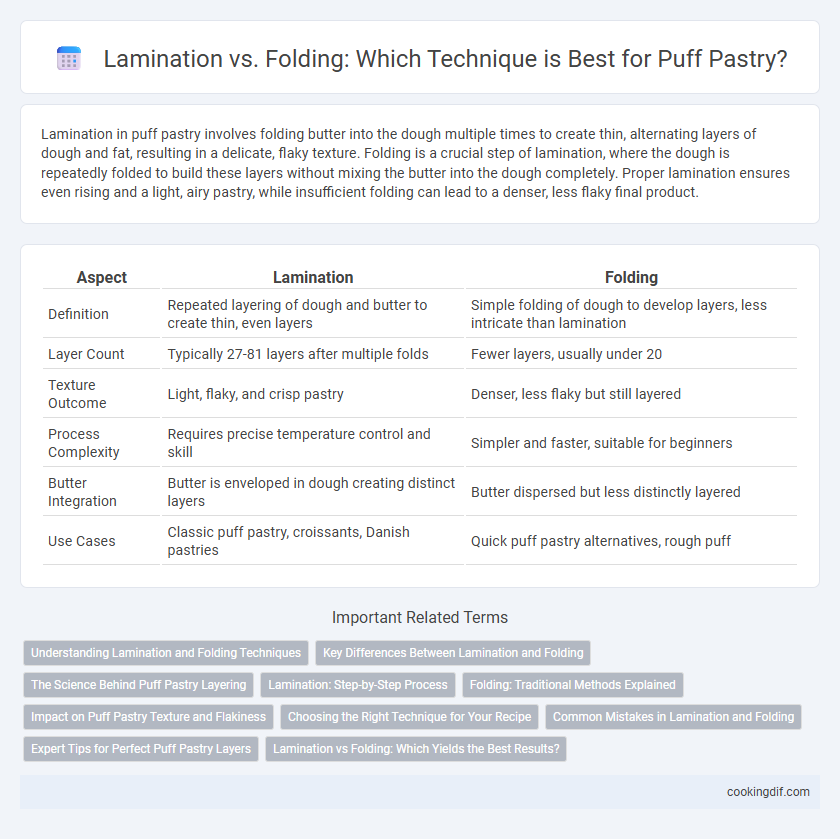Lamination in puff pastry involves folding butter into the dough multiple times to create thin, alternating layers of dough and fat, resulting in a delicate, flaky texture. Folding is a crucial step of lamination, where the dough is repeatedly folded to build these layers without mixing the butter into the dough completely. Proper lamination ensures even rising and a light, airy pastry, while insufficient folding can lead to a denser, less flaky final product.
Table of Comparison
| Aspect | Lamination | Folding |
|---|---|---|
| Definition | Repeated layering of dough and butter to create thin, even layers | Simple folding of dough to develop layers, less intricate than lamination |
| Layer Count | Typically 27-81 layers after multiple folds | Fewer layers, usually under 20 |
| Texture Outcome | Light, flaky, and crisp pastry | Denser, less flaky but still layered |
| Process Complexity | Requires precise temperature control and skill | Simpler and faster, suitable for beginners |
| Butter Integration | Butter is enveloped in dough creating distinct layers | Butter dispersed but less distinctly layered |
| Use Cases | Classic puff pastry, croissants, Danish pastries | Quick puff pastry alternatives, rough puff |
Understanding Lamination and Folding Techniques
Lamination involves repeatedly folding dough around layers of butter to create thin, even sheets that result in a flaky, airy puff pastry texture. Folding techniques, such as book folds or letter folds, control the number of layers, ensuring consistent rise and crispness during baking. Mastering precise lamination and structured folding enables optimal layer development essential for high-quality puff pastry.
Key Differences Between Lamination and Folding
Lamination involves encasing a block of butter within dough and repeatedly rolling and folding to create multiple thin layers essential for puff pastry's flaky texture. Folding refers to the specific technique used during lamination where the dough is folded onto itself to develop these layers, but folding can also describe simpler dough manipulations in other pastries. The key difference lies in lamination being the overall process of layering butter and dough, while folding is a critical step within that process to achieve the distinct puffed structure.
The Science Behind Puff Pastry Layering
Puff pastry's distinct flakiness results from the lamination process, which involves repeatedly folding and rolling dough with layers of butter to create hundreds of thin, alternating layers. The science behind lamination relies on steam generated from the butter during baking, causing the layers to puff and separate, while folding ensures even distribution and thickness of these layers. Properly executed lamination optimizes gluten development and moisture retention, producing the characteristic light, airy texture of high-quality puff pastry.
Lamination: Step-by-Step Process
Lamination for puff pastry involves repeatedly folding and rolling dough with layers of butter to create hundreds of thin, flaky layers. The process begins by encasing a solid block of cold butter within the dough, followed by a series of precise folds--usually three to four "turns"--to evenly distribute the butter without melting it. Each fold and roll exponentially increases the number of layers, essential for achieving the light, airy texture characteristic of classic puff pastry.
Folding: Traditional Methods Explained
Folding in puff pastry involves carefully layering dough and butter to create thin, alternating sheets that result in a flaky texture when baked. Traditional methods emphasize precise temperature control and consistent folds, typically using a series of three- or four-fold turns to achieve the desired lamination without melting the butter. This meticulous folding technique ensures uniform layers that contribute to the signature rise and crispiness of high-quality puff pastry.
Impact on Puff Pastry Texture and Flakiness
Lamination creates multiple thin butter layers between dough sheets, resulting in an ultra-flaky, airy puff pastry texture with distinct, crisp layers. Folding techniques distribute the butter more evenly without creating as many layers, producing a denser, less flaky final product. Optimal lamination enhances puff pastry's characteristic rise and delicate crunch by maximizing steam release during baking.
Choosing the Right Technique for Your Recipe
Lamination creates distinct, flaky layers by alternating butter and dough through multiple folds, ideal for puff pastry recipes requiring a delicate rise and crisp texture. Folding focuses on evenly distributing butter within the dough but involves fewer layers, suitable for denser pastries that prioritize structure over flakiness. Selecting the technique depends on the desired final texture and rise, with lamination preferred for airy, buttery pastries and folding for sturdier, more uniform results.
Common Mistakes in Lamination and Folding
Common mistakes in lamination for puff pastry include uneven dough thickness, which causes inconsistent rising, and insufficient chilling between folds that leads to butter leakage and a greasy final product. During folding, overworking the dough can develop excess gluten, resulting in a tough texture rather than the desired flakiness. Precise temperature control and careful handling of butter layers are crucial to avoid these errors and achieve the signature airy, layered structure of puff pastry.
Expert Tips for Perfect Puff Pastry Layers
Lamination involves repeatedly folding and rolling dough with butter to create hundreds of thin, buttery layers essential for flaky puff pastry, while folding primarily refers to the technique of turning and layering dough to build structure. Expert tips emphasize maintaining a cold environment to prevent butter melting, using sharp dough edges for cleaner folds, and performing exact turns for uniform layer thickness. Precision in temperature control and consistent fold counts--typically six to eight--are crucial for achieving perfect puff pastry rise and texture.
Lamination vs Folding: Which Yields the Best Results?
Lamination, involving repeated rolling and layering of dough with butter, creates distinct, flaky layers essential for classic puff pastry texture, while folding primarily redistributes butter and dough without establishing defined layers. Lamination results in superior puff rise and crispiness due to steam trapped between layers during baking, a quality folding alone cannot achieve. Professional bakers prioritize lamination to ensure optimal flakiness and volume, distinguishing high-quality puff pastry from simpler laminated dough variants.
Lamination vs Folding for puff pastry Infographic

 cookingdif.com
cookingdif.com